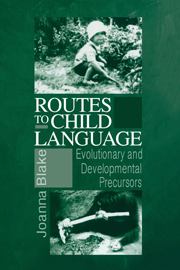Book contents
- Frontmatter
- Contents
- Preface
- 1 Prelinguistic Vocalizations
- 2 Sound–Meaning Correspondences
- 3 Communicative Gestures
- 4 Symbolic Gestures and Symbolic Play
- 5 Tool Use and Object Concept
- 6 Representation in Human Infants
- 7 Memory in Nonhuman Primates and Young Children
- 8 Origins of Language
- 9 Recapitulation
- References
- Index
8 - Origins of Language
Published online by Cambridge University Press: 12 January 2010
- Frontmatter
- Contents
- Preface
- 1 Prelinguistic Vocalizations
- 2 Sound–Meaning Correspondences
- 3 Communicative Gestures
- 4 Symbolic Gestures and Symbolic Play
- 5 Tool Use and Object Concept
- 6 Representation in Human Infants
- 7 Memory in Nonhuman Primates and Young Children
- 8 Origins of Language
- 9 Recapitulation
- References
- Index
Summary
There is an abundance of hypotheses about the origins of language. In this chapter, I examine some of them and attempt to relate them to the research findings that have been reviewed in the previous chapters. Although the field is often – necessarily – speculative, new findings about the brain have enabled some progress beyond speculation. The hypotheses I address here are focused on brain–body ratio and brain structure, gestures, cognitive culture, information donation, symbolic reference, and the “hopeful monster” theory (the label applied by Deacon, 1997, to the Chomskian theory of language origins).
Brain–Body Ratio and Brain Structure
The brain–body ratio in humans greatly exceeds that in nonhuman primates (although not apparently that in mice and other small mammals [Deacon, 1997]). Although prenatal brain growth in humans follows the typical primate pattern, it grows more than would be expected after birth, but body growth is truncated. If our bodies had continued along the ape ratio, we would be giants. Most of the “extra” brain is an expansion of the prefrontal cortex, with the human cerebellum also displaying a proportionate increase in size (Elman et al., 1996). Recently, the role of both of these areas in language has been emphasized. Most proponents of the brain–body ratio hypothesis of language origin view the increase in this ratio as causal in the evolution of language. Species with a greater ratio have more brain free for nonsomatic functions – that is, cognitive ones.
- Type
- Chapter
- Information
- Routes to Child LanguageEvolutionary and Developmental Precursors, pp. 213 - 227Publisher: Cambridge University PressPrint publication year: 2000



